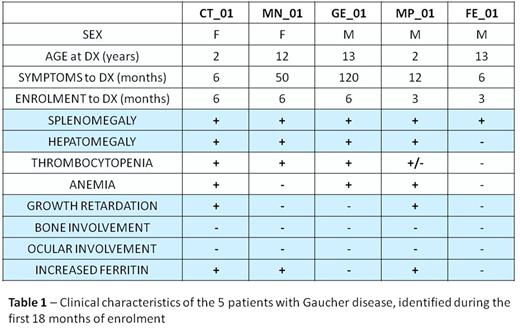Abstract
BACKGROUND: Gaucher disease (GD) is an autosomal recessive lysosomal storage disease characterized by the deficient activity of beta-glucocerebrosidase (GBA). GBA deficiency results in the accumulation of glucosylceramide in different organs, causing tissue damage. Typical GD features are spleno-hepatomegaly, peripheral blood cytopenias (mostly thrombocytopenia and/or anemia), growth retardation, bone involvement, gammopathies, increased risk of malignancies and, in some patients, neurological manifestations.
Since symptoms are non-specific, the diagnosis can be delayed for years or missed.
Enzyme replacement therapy (ERT) with recombinant β-glucocerebrosidase is safe and effective in preventing and/or reversing many clinical manifestations. However, if the diagnosis is delayed for years, major complications cannot be reversed.
A useful screening method for GD is based on measuring enzyme activity on a Dried Blood Spot (DBS), while the gold standard test is still considered GBA activity in cellular homogenates.
A pediatric algorithm has been proposed to promote timely diagnosis and early access to ERT (Di Rocco M et Al, Ped Blood & Cancer 2014;61:1905-09).
AIMS: Since pediatric patients with splenomegaly and cytopenias are usually referred to pediatric hematologists, we have designed the GAU-PED study to evaluate the prevalence of GD among children referred to the haematology paediatric units and selected according to the above mentioned diagnostic algorithm. Here, we report a preliminary analysis of GAU-PED trial at 18 months after the start of the enrolment.
METHODS: The GAU-PED study involves 53 centers in the context of the AIEOP Study Group, the Italian clinical research consortium in paediatric hematology and oncology.
Patients (1-18 years old) referring to the pediatric hematology and oncology units for spleno-w/wo hepatomegaly and cytopenia (thrombocytopenia and/or anaemia), where other causes of splenomegaly has been excluded, are tested for GBA activity though a DBS sample. Only patients with DBS showing a GBA activity below normal values are recalled to confirm GBA enzyme deficiency using the gold standard GBA analysis in cell omogenate. For every tested patient, clinical information are also collected.
RESULTS: During the first 18 months of accrual, a total of 47 DBS have been collected from 18 centers, after parental consent. DBS values under 5 pmol/punch(1)/h(1)were found in 19/47 patients (40%). These patients have been recalled for the conventional enzymatic test. The diagnosis of GD has been confirmed in 5/19 (26%) DBS positive patients. In all 5 patients the genetic analysis has been consistent with GD.
Overall, in the tested population, the prevalence of GD is 10.6% (95% CI, 4 - 24%) equal to 5/47 enrolled patients.
Three patients were females and 2 males. The mean age at diagnosis was 8.4 years (range 2 - 13 years). The median time from the initial clinical presentation and the diagnosis has been 12 months (range 6-120 months), while the mean time between the DBS test and the diagnosis has been 4.8 months (range 3 - 6 months). ERT has been started in all GD patients. The clinical characteristics of the 5 patients with GD are summarized in Table 1.
CONCLUSION/SUMMARY: Our preliminary results support the use of DBS as screening test for GD in a selected population of children with splenomegaly and/or thrombocytopenia considered at increased risk for the disease. The use of an appropriate diagnostic algorithm is useful to increase awareness of GD among pediatric hematologists and to shorten the time to diagnosis. Taking in consideration the long life expectancy of pediatric GD patients, the early diagnosis will have a strong impact on health and quality of life.
No relevant conflicts of interest to declare.
Author notes
Asterisk with author names denotes non-ASH members.


